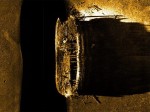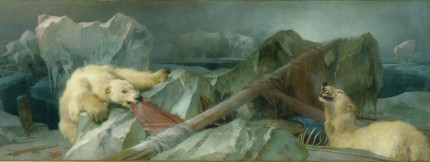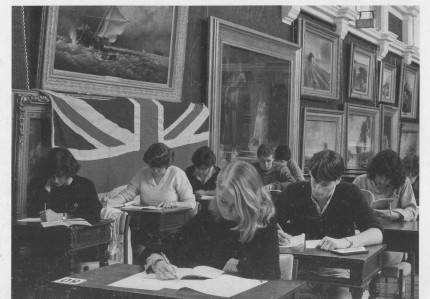 The shipwreck found last month near King William Island in the eastern Queen Maud Gulf has been identified as Franklin’s flagship, the HMS Erebus. Captained by explorer Sir John Franklin on the hunt for the legendary Northwest Passage, Erebus and its companion ship HMS Terror got stuck in the ice in September of 1846. Nearly 130 souls were lost and as were the ships. People have been searching for the Franklin ships ever since.
The shipwreck found last month near King William Island in the eastern Queen Maud Gulf has been identified as Franklin’s flagship, the HMS Erebus. Captained by explorer Sir John Franklin on the hunt for the legendary Northwest Passage, Erebus and its companion ship HMS Terror got stuck in the ice in September of 1846. Nearly 130 souls were lost and as were the ships. People have been searching for the Franklin ships ever since.
 When a coalition of private and public organizations led by Parks Canada discovered the ship on September 7th, they weren’t certain which of the two Franklin vessels it was. Storms kept researchers from exploring the wreck for three days, leaving only a brief two-day window before the temperatures dropped below zero and put an end to the summer campaign. They made those two days count, sending four two-man teams on seven dives lasting a cumulative 12 hours. The divers took high resolution photographs, high-definition video and measurements of the wreck
When a coalition of private and public organizations led by Parks Canada discovered the ship on September 7th, they weren’t certain which of the two Franklin vessels it was. Storms kept researchers from exploring the wreck for three days, leaving only a brief two-day window before the temperatures dropped below zero and put an end to the summer campaign. They made those two days count, sending four two-man teams on seven dives lasting a cumulative 12 hours. The divers took high resolution photographs, high-definition video and measurements of the wreck
 It was the measurements taken during the dives that allowed the research team to identify it as HMS Erebus. The ship is such a good state of preservation that it was possible to compare the measurements to the plans of the ship at the UK National Maritime Museum in Greenwich. Erebus is longer and wider than Terror and the measurements and sonar data found that length and breadth aligned with the Erebus plans. The position of certain deck structures also matched Erebus, not Terror.
It was the measurements taken during the dives that allowed the research team to identify it as HMS Erebus. The ship is such a good state of preservation that it was possible to compare the measurements to the plans of the ship at the UK National Maritime Museum in Greenwich. Erebus is longer and wider than Terror and the measurements and sonar data found that length and breadth aligned with the Erebus plans. The position of certain deck structures also matched Erebus, not Terror.
 No artifacts have been recovered as the divers did not go inside themselves. With the limited time they had, researchers would not have been able to explore the interior with the kind of diligence required for a maritime archaeological exploration. The team will be returning next summer (and who knows how many summers after that), so these two days were more gainfully employed surveying the structure and layout of the site. Parks Canada underwater archaeologist Ryan Harris:
No artifacts have been recovered as the divers did not go inside themselves. With the limited time they had, researchers would not have been able to explore the interior with the kind of diligence required for a maritime archaeological exploration. The team will be returning next summer (and who knows how many summers after that), so these two days were more gainfully employed surveying the structure and layout of the site. Parks Canada underwater archaeologist Ryan Harris:
“As an archaeological and underwater site, it’s complex and novel, in that it’s a significant three-dimensional structure that we’re going to have to figure out to work inside the interior spaces,” he said.
They did send a camera through an opening in the deck to get a glimpse of the interior of the ship. They were able to view the ship’s galley and the crew’s sleeping quarters. They also saw a mechanism that was part of the custom alterations done to the ship especially for the expedition: a lift that pulled the propeller out of the water up a bronze track to save it from being damaged in thick ice.
Exploring the interior of the stern is a high priority. That’s where Franklin’s cabin and log room were. It’s possible that there could be surviving documents, believe it or not, because the logs were written on rag paper that is very durable and because the cold and darkness of the Arctic water is an excellent preservative. Even if the ink has washed off, imaging technology could detect what was written on any surviving pages.

On a tangentially related note, the discovery has brought to the fore a macabre but awesome story involving a cursed painting that freaked out students taking their exams. In 1864, Sir Edwin Landseer exhibited a painting he’d done inspired by the lost Franklin expedition. It’s entitled Man Proposes, God Disposes and features two ravenous polar bears tearing into the wreck of a ship and the skeletal remains of one of its crew members.
 It made a strong impression on critics who described it using words like “tragic grandeur” and “living fire of imagination” and was by far the most popular piece at the Royal Academy that year. Lady Franklin and the Admiralty were less enthused. At best the scene was a horrific depiction of Franklin’s fate. At worst those bears were allegorical references to reports that the crew had succumbed to cannibalism which had been very much in the news since Captain John Rae of the Hudson Bay Company had returned from a rescue expedition in 1854 with Inuit testimony of mutilated bodies and bones in kettles. You can read both sides of the cannibalism question debated in Charles Dickens’s literary journal, Household Worlds. Dickens believed Franklin and the fine men of the British navy would never stoop to such behavior. He made his moral argument in two parts, then printed Rae’s response also in two parts.
It made a strong impression on critics who described it using words like “tragic grandeur” and “living fire of imagination” and was by far the most popular piece at the Royal Academy that year. Lady Franklin and the Admiralty were less enthused. At best the scene was a horrific depiction of Franklin’s fate. At worst those bears were allegorical references to reports that the crew had succumbed to cannibalism which had been very much in the news since Captain John Rae of the Hudson Bay Company had returned from a rescue expedition in 1854 with Inuit testimony of mutilated bodies and bones in kettles. You can read both sides of the cannibalism question debated in Charles Dickens’s literary journal, Household Worlds. Dickens believed Franklin and the fine men of the British navy would never stoop to such behavior. He made his moral argument in two parts, then printed Rae’s response also in two parts.
In his response, Rae specifically rebutted the contention that those gnawed bones could have been the work of polar bears.
Had there been no bears thereabouts to mutilate those bodies — no wolves, no foxes? is asked; but it is a well-known fact that, from instinct, neither bears, wolves, nor foxes, nor that more ravenous of all, the glutton or wolverine, unless on the verge of starvation, will touch a dead human body ; and the carnivorous quadrupeds near the Arctic sea are seldom driven to that extremity.
Franklin’s crew certainly were driven to that extremity, however, and the Inuit who told Rae about it also found Franklin’s telescope which is in the painting.
Victorian patent medicine mogul Thomas Holloway bought the painting at auction in 1881. Holloway died in 1883; in 1886, Man Proposes, God Disposes moved to Royal Holloway College, the all women’s college he had founded in 1879. It now hangs in the school’s Picture Gallery at eye level to students trying to take their exams.
“Originally, it was bad luck if you sat next to it. We really do not know where the rumour started. It must be the subject matter – the biggest failure that Victorian Britain tackled up to that point,” said Royal Holloway curator Dr. Laura MacCulloch.
“When you look at this picture, it’s so miserable and so bleak.”
Yet for one student in the 1970s, the thought of sitting next to a depiction of such failure while writing exams invoked a strong protest.
“The poor registrar had to find something to cover it and the only thing that was big enough was a Union Jack,,” said Dr MacCulloch.
To this day, the painting is covered by the Union flag while students sit exams but Dr MacCulloch denied a story that the painting’s curse was so strong that a student who sat by it committed suicide, leaving a diary entry saying ‘the polar bears made me do it’.
“There is no evidence of that ever happening,” she clarified.

Thanks for this story!
The Franklin Expedition is the granddaddy of all the grim and compelling mysteries associated with polar exploration. I doubt that investigations of the Erebus will answer all the questions surrounding the expedition’s fate, but I bet some fascinating information will come to light. I look forward to reading about it here.
By the way, for anyone interested, Dan Simmons’ novel The Terror is a bleak, beautiful, and bizarre meditation on the Franklin Expedition story. I highly recommend it.
Wonderful post! And any future posts on cursed works of art would be highly welcome in this quarter.
I love the story of the “cursed” painting – though I think I’d find the covered picture more distracting. Then again, maybe I’ve read too many “painting that changes every time you look at it” stories to be quite comfortable with covering one up!
I’m trying very hard to be patient about the Erebus exploration, realizing that even if all goes well with next season’s researches, the study and preservation of any finds could take much longer. But this story fascinates me, and I’ve been catching up on my Arctic-exploration reading by way of passing the time {wry grin}. Fleming’s Barrow’s Boys is excellent, and the new book In the Kingdom of Ice by Hampton Sides, about the voyage of the Jeanette, is quite good as well. [I enjoyed Simmons’ novel The Terror, though I was a bit upset that he cast a couple of the actual crew members as terrible, terrible villains; I’d have preferred it if he’d made up a few bonus crew members to turn into sociopaths.]
What a wonderful find and a wonderful tale of human foibles!
Reading about the searches for the North East and North West passages is a grim occupation.
Funny you should mention the Simmons habit of turning real people into fictional villains. I was just thinking this morning about how he did the same thing with Wilkie Collins in Drood.
Collins is long dead and not well remembered, but I had to wonder about the ethics of characterizing him in such an awful light.
The Flight of the Eagle by Per Olaf Sundman is another good (and very bleak) novelization of a 19th century arctic expedition.
I read The Terror several years after discovering the Franklin story. I always thought that, while some parts are fantasy, the descriptions of the struggle were spot on.